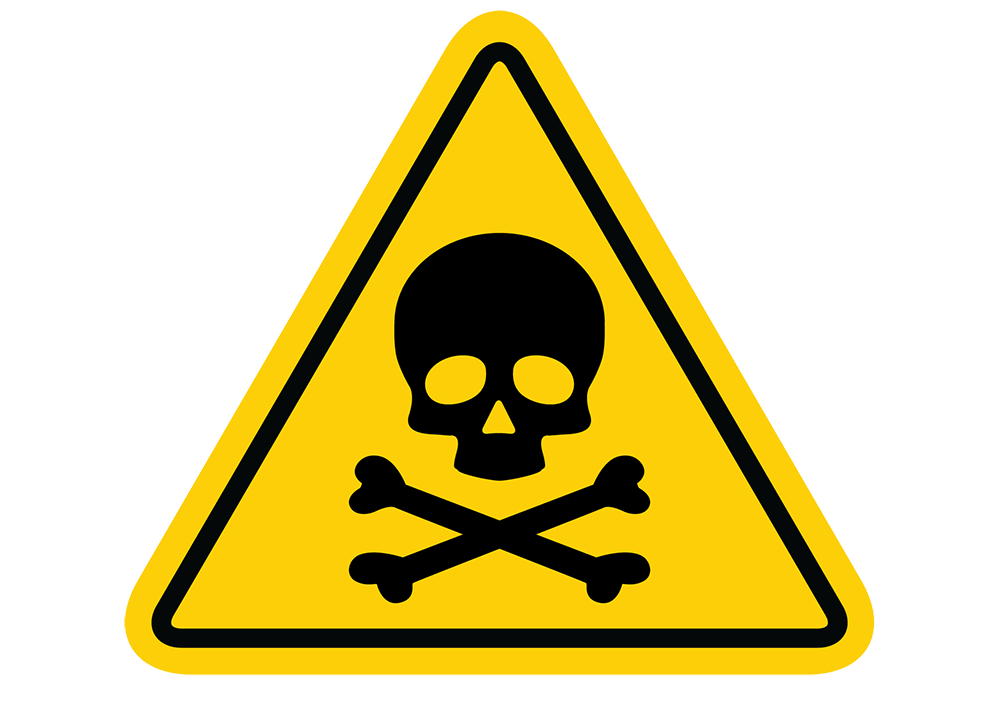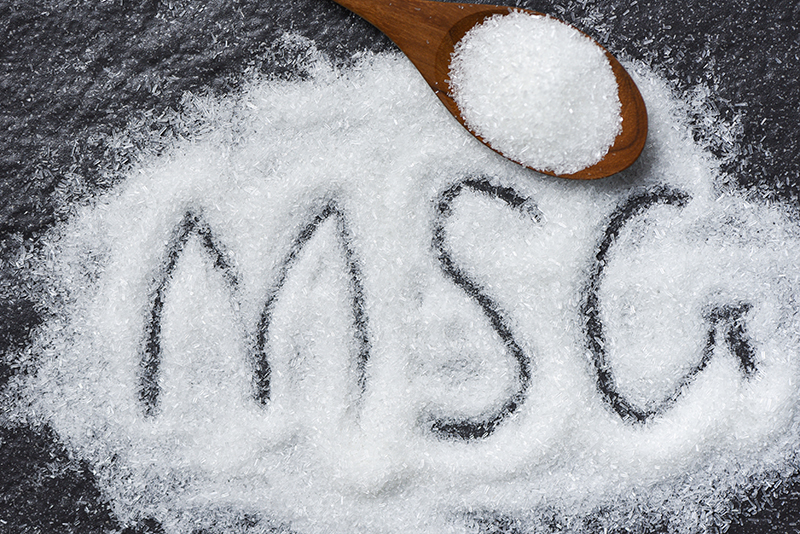Ajinomoto is the Japanese brand name for monosodium glutamate (MSG). It is also the name of the unimaginably rich and powerful company behind the campaign to convince unsuspecting consumers that MSG (and the excitotoxic free glutamate in it) — both manufactured by Ajinomoto — are harmless “safe” food ingredients. They also want you to believe that MSG (which contains relatively little sodium) should be used as a salt substitute.
Umami: the con of the decade?
It has always been my opinion that the concept of umami was developed to promote the sale of monosodium glutamate, with a very large enterprise developed to promote the fiction.
When I was first introduced to “umami” I had a creeping suspicion that the concept of umami had been promoted in an effort to legitimize the use of monosodium glutamate in food, drawing attention away from the fact that monosodium glutamate is a neurotoxic amino acid which kills brain cells, is an endocrine disruptor (causing obesity and reproductive disorders), and is the trigger for reactions such as asthma, migraine headache, seizures, depression, irritable bowel, hives, and heart irregularities.
It’s common knowledge that there are glutamate receptors in the mouth and on the tongue. Could researchers be hired to produce studies demonstrating that glutamate containing food can stimulate those glutamate receptors, and then declare to the world that a fifth taste has been discovered — calling it umami? I wondered.
Never mind that for years monosodium glutamate was described as a tasteless white crystalline powder. Never mind that Julia Child, who in her later years was recruited to praise the use of monosodium glutamate, never once mentioned the additive in her cookbooks. Never mind that if there was taste associated with monosodium glutamate, people who are sensitive to MSG would be highly motivated to identify that taste and thereby avoid ingesting MSG – which they claim they cannot do.
It certainly would be wonderful, I thought, if the glutamic acid in processed free glutamic acid (MSG) had a delicious, robust, easily identifiable taste of its own. Even if the taste was unpleasant instead of delicious, it would still be wonderful — at least the adults who are sensitive to MSG could identify the additive in their food and avoid eating it. MSG-induced migraine headaches, tachycardia, skin rash, irritable bowels, seizures, depression, and all of the other MSG-induced maladies, could become nothing more than bad memories.
Sometime after Olney and others demonstrated that monosodium glutamate was an excitotoxin — killing brain cells and disrupting the endocrine system — Ajinomoto, Co., Inc. began to claim that their researchers had identified/isolated a “fifth taste.” The “fifth taste,” they said, was the taste of processed free glutamic acid. This alleged fifth taste was branded “umami.”
The word “umami” has been in the Japanese vocabulary for over a century, being in use during the Edo period of Japanese history which ended in 1868. In the 1990s, it was written that “umami” can denote a really good taste of something – a taste or flavor that exemplifies the flavor of that something. It was said that the taste of monosodium glutamate by itself does not in any sense represent deliciousness. Instead, it is often described as unpleasant, and as bitter, salty, or soapy. However, when monosodium glutamate is added in low concentrations to appropriate foods, the flavor, the pleasantness, and the acceptability of the food increases.
For years, certainly up to the turn of this century, monosodium glutamate had been thought of as a flavor enhancer – like salt. Something that enhances the taste of the food to which it is added. Early encyclopedia definitions of monosodium glutamate stated that monosodium glutamate was an essentially tasteless substance. The idea (advanced by Ajinomoto) that monosodium glutamate has a taste of its own, as opposed to being a flavor enhancer, is relatively recent. Not just a taste of its own, mind you, but something newsworthy that could attract national or international attention. A fifth classification of taste added to the recognized tastes of sweet, salty, bitter, and sour.
The idea that monosodium glutamate has a unique taste can be tracked in the scientific literature if you read vigilantly. I don’t know whose brainchild it was, but it certainly was a brilliant move on the road to marketing monosodium glutamate – a move precipitated by a growing public recognition that monosodium glutamate causes serious adverse reactions. And even one step farther up the brilliance chart, this monosodium-glutamate-taste-of-its-own was given a name. Naming things makes them easy to talk about and gives them respectability. The monosodium-glutamate-taste-of-its-own was named “umami.”
We started writing about umami years ago. We were already familiar with the research that the glutamate industry used to claim that umami was a fifth taste, and we knew that, with possible rare exception, all of that research had been funded by Ajinomoto and/or their friends and agents. We also sensed that researchers outside of the direct employ, or outside of the indirect largess of the glutamate industry, found the idea of a fifth taste to be without merit.
We thought that we should begin by making the case that what was called the “taste” produced by monosodium glutamate is not a taste, per se, but is little or nothing more than the vague sensation that nerves are firing. We would start by reminding our readers that what industry calls the “taste” of monosodium glutamate is its manufactured free glutamic acid; that glutamic acid is a neurotransmitter; and that as a neurotransmitter, glutamic acid would carry nerve impulses to nerve cells called glutamate receptors, and trigger responses/reactions. Then we would explain that there are glutamate receptor cells in the mouth and on the tongue, and that monosodium glutamate could trigger reactions in those glutamate receptors — leaving the person who was ingesting the monosodium glutamate with the perception that food being ingested with it had a bigger, longer lasting taste than it would have had if there was no monosodium glutamate present.
Ask Ajinomoto, and they will tell you that there are studies that prove that umami is a fifth taste. Review of those studies has proved to be extremely interesting, but when read carefully, offers no proof that monosodium glutamate does anything more than stimulate receptors in the mouth and on the tongue and promote the perception of more taste than the ingested food would otherwise provide.
I actually spoke with one of the umami researchers on the phone, a Dr. Michael O’Mahoney, Professor in the Department of Food Science and Technology, UC Davis. He was doing research for the glutamate industry and, therefore, could certainly provide information.
Dr. O’Mahoney was warm and friendly, but said that because he had a contract with Ajinomoto to study the taste of monosodium glutamate he was not able to share information with me. An academician who refused to share information was an animal I had not met before.
Based on personal observations and conversations with MSG-sensitive friends, I have become increasingly certain that monosodium glutamate has no taste; that in stimulating the glutamate receptors in the mouth and on the tongue, glutamate causes the person ingesting monosodium glutamate to perceive more taste in food than the food would otherwise have; that umami is a clever contrivance/device/public relations effort to draw attention away from the fact that processed free glutamic acid and the monosodium glutamate that contains it are toxic.
And taste? A savory taste? Given what I know about Ajinomoto’s rigging studies of the safety of monosodium glutamate, I couldn’t help but wonder if they might have done something unsavory to support their claim that monosodium glutamate has a savory taste.
- They certainly have studies allegedly demonstrating that monosodium glutamate has a savory taste. Were those studies rigged?
- Did Ajinomoto feed something to the genetically modified bacteria that excrete their glutamic acid that would cause the glutamic acid to have a taste? A savory taste?
- When the L-glutamic acid used in monosodium glutamate is produced, there are unavoidable by-products of production. Does one of those by-products contribute a savory taste?
- Is some savory flavoring added to the monosodium glutamate product before it leaves the Eddyville plant?
- Is “savory taste” a fiction invented by Ajinomoto and reinforced through repetition of the concept?
When it comes down to what really matters, whether there are four or five tastes is irrelevant.
When it comes down to what really matters, whether monosodium glutamate is a flavor enhancer or a flavor itself is inconsequential.
What really matters is that chemical poisons are being poured into infant formula, enteral (invalid) care products, dietary supplements, pharmaceuticals and processed foods — and one of those chemical poisons is manufactured free glutamic acid, found in monosodium glutamate and four dozen or so other ingredients with names that give no clue to its presence. That’s my opinion.
Adrienne Samuels, Ph.D.
Director, The Truth in Labeling Campaign
Calling MSG ‘umami’ doesn’t make it any less poisonous
Have you caught on yet? Since the world is beginning to catch on to the fact that monosodium glutamate (MSG) causes brain damage along with migraine headaches, asthma, seizures and more, and neuroscientists are looking at the role it plays in neurodegenerative diseases like Alzheimer’s, Parkinson’s and ALS, MS, autism, and depression, its producer Ajinomoto is busy (you might say shrewdly) referring to it by the pleasant-sounding name umami, while keeping its poisonous properties intact.
Here’s the latest “MSG-is-safe” advertisement, disguised as an article, received by the Truth in Labeling Campaign: https://www.popsci.com/science/umami-flavor/
If you have questions or comments, we’d love to hear from you. If you have hints for others on how to avoid exposure to MfG, send them along, too, and we’ll put them up on Facebook. Or you can reach us at questionsaboutmsg@gmail.com and follow us on Twitter @truthlabeling.
More powerful than evidence
In preceding weeks we presented seven lines of evidence pointing to the toxicity of manufactured free glutamate (MfG), the toxic component of monosodium glutamate (MSG). But despite this evidence, those charged with protecting the health of Americans continue to maintain that MfG and MSG in amounts readily available to consumers are “safe.” So, today we introduce you to the world of power and greed where the myths of MSG and MfG safety are kept alive – a world in which industry generated lies are parroted by media of every description, and truth has no value.
Not lines of evidence per se, but significant contributions to keeping the myth of MSG and MfG safety flowing in the media are the roles played by the U.S. Food and Drug Administration (FDA) and their related agencies, the legislators who fail to administer appropriate oversight of those agencies, and the misrepresentations, lies, and dirty tricks that make up the agenda of the glutamate industry as they promote sales of their toxic ingredient.
Roles played by the U.S. Food and Drug Administration (FDA) and related agencies:
https://www.truthinlabeling.org/assets/industrys_fda_final.pdf
Misrepresentations, lies, and dirty tricks that make up the agenda of the glutamate-industry as they strive to promote sales of their toxic ingredient:
- Misrepresentations, lies, and FDA patronage. They lie at the heart of the glutamate-industry’s efforts to hide the fact that MSG is toxic: https://www.truthinlabeling.org/assets/lies_final.pdf
- The fail-safe way to ensure that studies conclude that MSG is harmless. The Glutes used this for years until it was made known that their so-called placebos would cause reactions identical to reactions caused by MSG test material: https://www.truthinlabeling.org/assets/designed_for_deception_short.pdf
- The hidden agenda. The Toxicity/Safety of Processed Free Glutamic Acid (MSG): A Study in Suppression of Information: https://www.truthinlabeling.org/assets/manuscript2.pdf
- Always ready to try something new: https://www.truthinlabeling.org/assets/ruse_final3.pdf
“Arranged” testimony of “authoritative bodies” to the safety of MSG.
The reviews done by what the glutamate industry refers to as “major regulatory agencies worldwide, all of which have concluded MSG is a safe ingredient,” were all based on reports of studies brought to those agencies by The Glutamate Association, the International Glutamate Technical Committee, their agents, or the FDA which since 1968 has ignored all evidence to the contrary and supported the false claim that MSG is a “safe” ingredient.
The FDA’s 50-year incestuous relationship with Ajinomoto, manufacturer of MSG — with the FDA parroting Ajinomoto’s misleading statements and down-right lies.
https://www.truthinlabeling.org/assets/industrys_fda_final.pdf
The falsehood spun that the glutamate added to food and the glutamate found in plants and animals are identical.
Not all glutamate is created equal. Some was created when man was created. Some is manufactured.
Glutamate has 2 enantiomers. In chemistry, an enantiomer is one of two stereoisomers that are mirror images of each other that are non-superposable (not identical), much as one’s left and right hands are mirror images.
Glutamate exists in two forms: 1) as a stand-alone amino acid (free) and 2) as an amino acid bound with other amino acids in protein (bound).
Free glutamate, when present in “excess” (more than the body needs for normal function) causes adverse reactions and brain damage. Glutamate bound in protein does not. When present outside of protein in amounts that exceed what the healthy human body was designed to accommodate, glutamate becomes an excitotoxic neurotransmitter, firing repeatedly, damaging targeted glutamate-receptors and/or causing neuronal and non-neuronal death by over exciting those glutamate receptors until their host cells die.
Free glutamate is rarely found in nature. Protein, which is composed of bound glutamate and a variety of other bound amino acids, is found in nature. Protein that is eaten is digested into individual (free) amino acids at which time glutamate becomes vital for normal body function being both a building block of future protein and the principal neurotransmitter in humans, carrying nerve impulses from glutamate stimuli to glutamate receptors throughout the body.
Manufactured glutamate (which is always free glutamate) is not identical to glutamate found unadulterated in nature. Contrary to what the manufacturer of free glutamate would have you believe, manufactured free glutamate is not identical to glutamate found unadulterated in nature. Try as they might, no one has been able to manufacture L-glutamate (the enantiomer that has flavor-enhancing capability) without producing unwanted by-products of manufacture at the same time. So, while the L-glutamate molecule is the L-glutamate molecule regardless of how it came to be, when the body ingests manufactured glutamate it becomes burdened with the by-products of L-glutamate manufacture (referred to as impurities) which include D-glutamate, pyroglutamate, and other molecules depending on the materials used to produce the L-glutamate and the extent of its processing.
In the healthy body, the amount of glutamate available for use is highly regulated, but when something goes wrong and there is more glutamate available than is needed (when there is “excess” glutamate), glutamate neurotransmitters fire, damaging targeted glutamate-receptors and/or causing neuronal and non-neuronal death by over exciting those glutamate receptors until their host cells die.
Prior to Ajinomoto’s 1957 change in method for producing glutamate, it would have been rare for there to be sufficient glutamate in a normal diet to cause that glutamate to become excitotoxic. Today there is sufficient glutamate in processed and ultra-processed foods for glutamate to become excitotoxic if multiple servings of glutamate-containing foods are consumed during the course of a day.
It is not necessary for humans to ingest glutamate in food because the body can make the glutamate it needs from other amino acids.
If you have questions or comments, we’d love to hear from you. If you have hints for others on how to avoid exposure to MfG, send them along, too, and we’ll put them up on Facebook. Or you can reach us at questionsaboutmsg@gmail.com and follow us on Twitter @truthlabeling.
Is MSG a toxin or a poison?
Although the terms “toxin” and “poison” are often used interchangeably, there are some significant differences. According to encyclopedia.com “A chemical is said to be a poison if it causes some degree of metabolic disfunction in organisms. Strictly speaking, a toxin is a poisonous chemical of biological origin, being produced by a microorganism, plant, or animal.” (Emphasis added.)
It goes on to say: “It is critical to understand that while any chemical can cause poisoning, a threshold of tolerable dose must be exceeded for this to actually happen.”
So, strictly speaking, MSG, which is manufactured by humans as opposed to being produced by a microorganism, plant, or animal, is a poison.
The Free Dictionary would seem to agree. It defines a poison as “a substance that, on ingestion, inhalation, absorption, application, injection, or development within the body, in relatively small amounts, may cause structural or functional disturbance.”
There are four very interesting facts about the poison in MSG.
1) The poisonous component of MSG is free glutamate. It’s free glutamate that triggers glutamate receptors, enhancing the flavor of food, and at the same time operating as a poison.
2) There are lots of products in addition to MSG that contain free glutamate. Just like the free glutamate in MSG, each enhances the flavor of the food with which it is eaten while it plays out its role as a poison.
3) Prior to 1957, tolerable doses of free glutamate would not have been exceeded, and the small amounts of free glutamate in processed foods would have not been poisonous. Prior to 1957, there wasn’t enough free glutamate in processed foods eaten during the course of a day to produce more free glutamate than could be tolerated.
4) In 1957, a revolutionary method for producing MSG and the free glutamate in it was introduced and the use of both MSG and other free glutamate-containing flavor-enhancers began to grow exponentially. From that point forward, the amount of free glutamate in processed foods easily exceeded the amount that could be ingested without causing adverse reactions and/or brain damage.
The dose makes the poison.
**********************************
Watch for it.
Over the course of the next few blogs the Truth in Labeling Campaign will be unveiling the Seven Lines of Evidence that lead inevitably to the conclusion that manufactured free glutamate (MfG), such as that found in hydrolyzed proteins and monosodium glutamate (MSG) is a well-disguised poison – a poison that may well be hidden in your very own pantry.
The first blog in the series will be August 24.
**********************************
If you have questions or comments, we’d love to hear from you. If you have hints for others on how to avoid exposure to MfG, send them along, too, and we’ll put them up on Facebook. Or you can reach us at questionsaboutmsg@gmail.com and follow us on Twitter @truthlabeling.
MSG isn’t natural
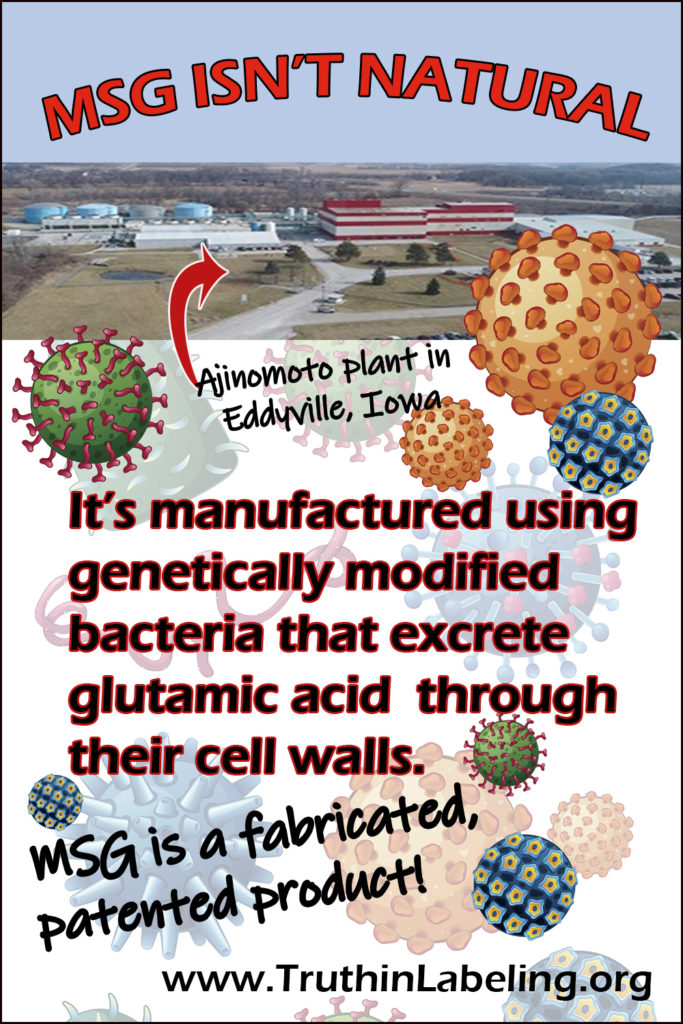
Watch for it.
Over the course of the next few blogs the Truth in Labeling Campaign will be unveiling the Seven Lines of Evidence that lead inevitably to the conclusion that manufactured free glutamate (MfG), such as that found in hydrolyzed proteins and monosodium glutamate (MSG) is a well-disguised poison – a poison that may very well be hidden in your own pantry.
_________________________________________
If you have questions or comments, we’d love to hear from you. If you have hints for others on how to avoid exposure to MfG, send them along, too, and we’ll put them up on Facebook. Or you can reach us at questionsaboutmsg@gmail.com and follow us on Twitter @truthlabeling.
Sucker?
It sure is easy to get sucked into the “MSG-is-safe” advertising. Let’s face it, they’re very good. They’ve hired the best. And we all can get pulled in.
I’m embarrassed to tell you how many times I’ve looked at the sentence “MSG is the salt form of the amino acid glutamate, which occurs naturally in a wide range of protein-rich foods and vegetables, such as shrimp, seaweed, and tomato,” and wondered if the sentence is designed to mean 1) “MSG,” a manufactured flavor enhancer, occurs naturally in food, or 2) “glutamate” occurs naturally in food.
It has only just occurred to me that the reader is supposed to come away with the idea that MSG occurs naturally in foods like shrimp, seaweed, and tomatoes. That, after all, is one of the glutamate industry’s essential lies.
The truth is that MSG is manufactured. It doesn’t occur naturally in anything.
Here the lie is just put more subtly than usual. Still, I can’t believe how long it took me to recognize this as fine-tuned propaganda designed to leave you and me with the misconception in our heads that MSG occurs naturally in food. That’s how good they are at deceptive and misleading advertising.
In case you’ve missed the glutamate industry’s list of essential inaccuracies, misrepresentations, and deceptions we’ve recapped it here.
The six big fat lies
#1: The glutamate contained in MSG is identical to the glutamate in the human body
#2: MSG is very well researched and found to be safe.
#3: It must be safe since the FDA has said so.
#4: MSG has been used for over a century without adverse reactions.
#5: MSG is naturally made, similar to yogurt, vinegar and wine.
#6: Monosodium glutamate occurs naturally in food.
Actually: MSG is manufactured using genetically modified bacteria that excrete glutamic acid through their cell walls. In the United States, monosodium glutamate is produced in Ajinomoto’s plant in Eddyville, Iowa.

The Whopper
Humans couldn’t eat enough Manufactured free Glutamic acid (MfG) to cause the brain damage, endocrine disorders, and assorted reactions that the laboratory animals had experienced.
In addition to out and out lies, there’s the question of the ethics of omission of facts relevant to the safety of a product. The FDA says that it is illegal to omit relevant information when describing drugs. That’s what the drug inserts are all about. But according to the FDA – and the legislators who fund them – telling the whole truth about poisonous ingredients doesn’t hold true for food.
A big push has been launched in Nigeria to promote sales of MSG and the Nigerian branch of the Japanese company that now manufactures it. As always, the propaganda aimed at Nigerians is attractive, persuasive, and delivered by authorities, celebrities and other “experts.” Following are snippets (all of them lies) taken from a July 25, 2021 article in Punch:
“The safety of AJI-NO-MOTO® has long been scientifically proven and its safety approved by authorized agencies of the United Nations.”
“An extensive body of research which has been reviewed by scientists and governments around the world, including the US FDA, the American Medical Association, experts of the United Nation’s Food and Agriculture Organization, World Health Organization and the European Commission’s Scientific Committee for Food demonstrates that glutamate is safe.”
“Umami seasoning, according to [the subject of the interview] has been safely used as food ingredient since 1908 after it was discovered by a Japanese scientist, Dr. Kikunae Ikeda.”
“MSG’s 113-years history of safety validated by health organizations across the globe,”
“MSG is found naturally in some foods including tomatoes and cheese.”
“MSG does not cause allergy; it does not cause asthma– no link at all; it does not cause obesity; no adverse effect on the lung. Again, no study has shown any group of people not to take glutamate.”
“Almost all seasoning contains MSG”
For more about the dangers posed by coming in contact with MfG (the poisonous ingredient in MSG) and the people who manufacture and market it, see:
There are seven lines of evidence leading to the conclusion that the manufactured free glutamate (MfG) in monosodium glutamate is toxic.
Data that demonstrate that glutamate in human tissue becomes excitotoxic – brain damaging – when present in amounts that exceed what a healthy person needs for normal body function.
Animal studies done in the 1970s that have demonstrated the toxicity of MSG and MfG.
And:
https://www.truthinlabeling.org/assets/Data_from_the_1960s_and_1970s_demonstrate.pdf
Animal data offered inappropriately as evidence that MSG is harmless.
Alerts from independent researchers warning of dangers posed by ingesting MSG.
Human studies that have demonstrated the toxicity of MSG.
Glutamate industry human studies rigged to produce negative results (no harm done by MSG).
Parkinson’s, Alzheimer’s, ALS, MS, epilepsy and 10+ other diseases all have this in common
It looks like Ajinomoto is fighting tooth and nail, pulling out all the stops to convince the public that their brain damaging (excitotoxic) monosodium glutamate (MSG) is harmless. They’re pouring millions of dollars into buying advertising space in newspapers throughout the world, issuing press releases, covertly publishing YouTube commercials dressed up as news, buying testimonials from celebrity chef, sports personalities, and good-looking young women who call themselves “sci moms.” They’ve mastered brainwashing on social media. Yet people keep getting sick after eating MSG. Not everyone, of course, just lots of people. And Ajinomoto’s MSG sales have been slipping.
There’s something else, too. Scientists are beginning to realize that somehow glutamate has something to do with increases in Parkinson’s disease, Alzheimer’s disease, multiple sclerosis, stroke, ALS, autism, schizophrenia, depression, obsessive-compulsive disorder (OCD), epilepsy, ischemic stroke, seizures, Huntington’s disease, addiction, attention-deficit/hyperactivity disorder (ADHD), frontotemporal dementia, and autism. No one has yet identified a cause and effect relationship, but the scientific community now recognizes that glutamate is associated with each of them. Data? A January 18, 2020 Medine search (www.pubmed.gov) for “glutamate-induced,” returned 3742 references.
If you have questions or comments, we’d love to hear from you. If you have hints for others on how to avoid exposure to MfG, send them along, too, and we’ll put them up on Facebook. Or you can reach us at questionsaboutmsg@gmail.com and follow us on Twitter @truthlabeling.
The art of lying about the safety of MSG
Straight from the horse’s mouth: How to tell your story, market your idea and sell your product without mentioning that its use could be lethal
Nobody does it better than Ajinomoto and their team of public relations specialists. Since 1957, when they changed the way they manufactured monosodium glutamate (a.k.a. MSG), and reports of reactions to MSG began to circulate, they’ve waged one hell of an effective marketing campaign aimed at convincing consumers (and anyone who might influence consumers) that MSG is harmless. And their success is evidenced by the facts that researchers in the United States rarely study the effects of MSG toxicity and medical journals don’t often publish studies that even suggest MSG might be toxic. Mainstream media dutifully carry Ajinomoto’s message while physicians don’t diagnose for MSG-sensitivity, and the FDA gives false testimony to the safety of MSG.
Recently, Jeryl Brunner writing in Forbes, interviewed one of Ajinomoto’s own, who showed us how it’s done.
Building Tia Rains’ expert/celebrity status
Brunner’s interview starts with Jeryl Brunner explaining that Tia Rains, an Ajinomoto executive, is “crusading to change the perception of monosodium glutamate.” Following are the feel-good words you’re supposed to associate with Tia Rains (without realizing that you’re being brainwashed). They’re used interchangeably by Rains and Brunner to build Rains’ expert/celebrity image.
- Nutrition (nutritionist)
- Scientist
- Nutritional scientist
- Her true calling
- Mastering the art
- Devoted
- Educating
- Optimize
- Understand
- Guru
- Inspired
- Swimmer (a sports figure)
- PhD
- Passion
- Research
Then there are statements about Tia Rains’ “crusade”:
- Her specialty is debunking misperceptions of maligned foods.
- She’s focused on translating nutrition science into application to advance public health.
- She’s dedicated to mapping out a communication approach that resonates with her audience.
The headline actually reads — “For Decades, This Nutrition Scientist And Marketing Guru Has Inspired Millions To Change Misperceptions.”
Brunner goes on to say,
“Nutrition scientist Tia Rains is devoted to educating people about the food they eat. Her passion for nutrition developed from being a child competitive swimmer. Rains knew that nutrition could optimize her performance and she wanted to understand how.
“For two decades Rains has spent most of her professional career mastering the art of nutrition communications. A PhD in nutritional sciences, her specialty is debunking misperceptions of maligned foods.
“Rains started at Kraft Foods where she found her true calling at the nexus of science and application. Then she lead nutrition research at a contract research organization. From there she moved to the Egg Nutrition Center where she led a successful effort against the public vilification of eggs.
“Her latest endeavor is crusading to change the perception of monosodium glutamate, better known as ‘MSG.’ As Vice President of Customer Engagement and Strategic Development at Ajinomoto Health & Nutrition North America, Rains is a health and nutrition advocate within the food and nutrition industry. She is focused on translating nutrition science into application to advance public health.”
Here’s how Rains would inspire you to change your opinion on MSG being toxic, using “art and science.”
Ordinarily, there would be five parts to the “art and science” of generating propaganda:
1. A positive image of the person delivering the message (an expert or a celebrity)
2. A recitation of the good things about the product,
3. A recitation of how the product (MSG) has been maligned,
4. A recitation of what’s bad about those who contradict claims that the product is worth buying, and,
5. A recitation of alleged “facts” – lies that people will be told about MSG.
In Brunner’s article, however, the focus is on the expertise of the person making the presentation as she exposes the root of all this “misinformation” (which, Rains says, is a 1968 article in the New England Journal of Medicine).
To accomplish that, Rains and Brunner use words that will resonate with her audience as she:
Builds sympathy for poor maligned MSG:
- “MSG is one of the most baselessly demonized ingredients in American history.”
- “We’re attempting to overturn a terrible and long history of xenophobia and misinformation.”
- “MSG became an easy target and the stigma took hold.”
Praises the success of her efforts to convince people that MSG is “safe”:
- “To date, her efforts have contributed to more than twelve million Americans becoming more positive toward the ingredient.”
Reinforces the positive image that Rains has built for herself:
- “I hope we can get to a place where we’re leaning more on science than personal feeling, or even fear.”
- “Every time I present facts and get someone to shift their perception, I’m reminded of why I do what I do.”
- “As a scientist, I’m an analytical thinker by training and recognize the importance of research and data. I am able to make science accessible and understandable for the average consumer. But I also think critically about the variety of factors that inform a perception and then see how we can work with researchers and experts to examine why they persist. Credible data is important when creating successful marketing campaigns.”
Urges followers to deliver a balance of logic and emotion:
- Be logical. Logic gives people confidence in the message.
- Play to the audience’s emotions. Emotion allows people to take ownership of Rains’ campaign and work to have others work with her to change their negative opinions about MSG.
Speaks of the benefits of using MSG:
- It’s critical for people to taste what MSG does to food and truly experience it.
- MSG can be used as a replacement for table salt.
Recites some of the half-truths told by the glutamate industry:
- “Decades of research validates MSG’s safety.”
(NOTE: the research said by Rains to validate MSG’s safety is badly flawed, in some cases using placebos made of excitotoxic amino acids that cause reactions identical to those caused by MSG.)
- “Public health organizations around the world stand by its use in the food supply.”
(NOTE: The organizations referred to by Rains did no research of their own on the safety of MSG (neither library nor laboratory research), but were given material to review by Ajinomoto and Ajinomoto’s agents, which includes the FDA.)
For more information see: https://www.truthinlabeling.org/assets/industrys_fda_final.pdf
For obvious reasons, neither Brunner nor Rains mentions brainwashing which, we have observed, is her basic modus operandi. Brainwashing can be accomplished in many different ways. Here it’s done by pairing the three letters MSG with feel-good words. Just as food was paired with ringing a bell for Pavlov’s dogs to condition them to salivate when a bell was rung, pairing “MSG” with happy, soothing words will make people feel good every time they think “MSG.”
What more could a propaganda artist ask for than a couple of pages of subtle brainwashing displayed on the pages of Forbes.
If you have questions or comments, we’d love to hear from you. And if you have hints for others on how to avoid exposure to MfG, send them along, too, we’ll put them up on Facebook. You can also reach us at questionsaboutmsg@gmail.com and follow us on Twitter @truthlabeling
Warning about the hazards of MSG can be hazardous to your reputation
By Linda and Bill Bonvie
Being accused of racism these days is no small matter. And those of Asian descent have seen an increase in incidents of racism targeting them.
So, when a reader review at Amazon.com appeared about our book, “A Consumer’s Guide to Toxic Food Additives,” accusing us of “promoting myths rooted in racism,” it was a bit of a shock, to say the least.
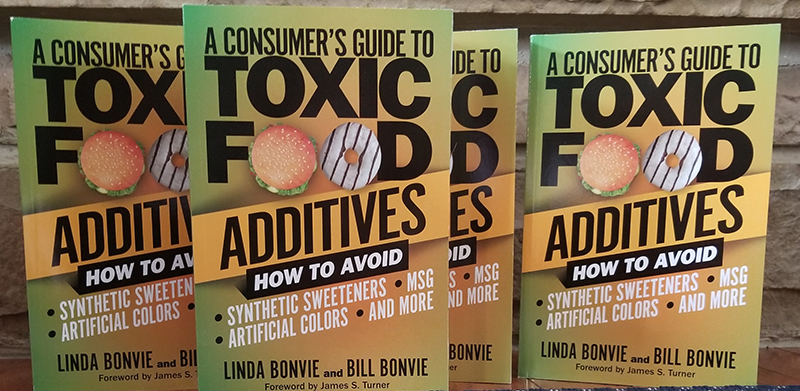
This reviewer, whose comment is called the “top” one from the U.S. (also somehow bumping any other reviews into obscurity), was in fact simply parroting information gleaned from various “news” stories appearing across the web.
It may sound crazy, but just by including warnings about consuming MSG in that book, we now were being accused of spreading a “myth deeply rooted in xenophobia.” In effect, consumer protection had somehow become redefined as ethnic bigotry directed specifically at Asian Americans.
You may be wondering, as we were, just where such a bizarre idea could have originated, and the answer is one that clearly shows how much influence PR agencies – especially large, well- connected ones – have over media of all sizes these days.
It stands to reason that manufacturers of questionable additives would attempt to counter warnings about their products with whatever industry-sponsored hype they could devise. But never did charges of “racism” enter into it until the “global communications” firm Edelman Public Relations entered the scene. They are being paid millions of dollars by Ajinomoto, the world’s largest manufacturer of monosodium glutamate, to conjure up the concept that legitimate concerns about the safety of MSG were nothing but racist myths.
Taking a cue from the removal of “misinformed historical symbols,” according to an Edelman press release, the Ajinomoto creative team apparently had an ‘aha moment’ when it coined “xenophobia-born misinformation” in an attempt to divert attention away from any negative science and adverse reactions associated with MSG.
Has it worked? If you go by the amount of media coverage received, such as this headline at CNN saying, MSG in Chinese food isn’t unhealthy – you’re just racist, activists say, this imaginary imagery seems to have taken hold, even filtering down to that “reader review” of our book. But Edelman, despite its ability to have media lists at its beck and call to run articles on how the term “No MSG,” constitutes racism, can’t seem to even monitor its own client list for conflicts of interest.
A question sent to the Del Monte press office about its College Inn broth product, for example, took a surprising turn with a return email from an Edelman representative speaking on the company’s behalf.
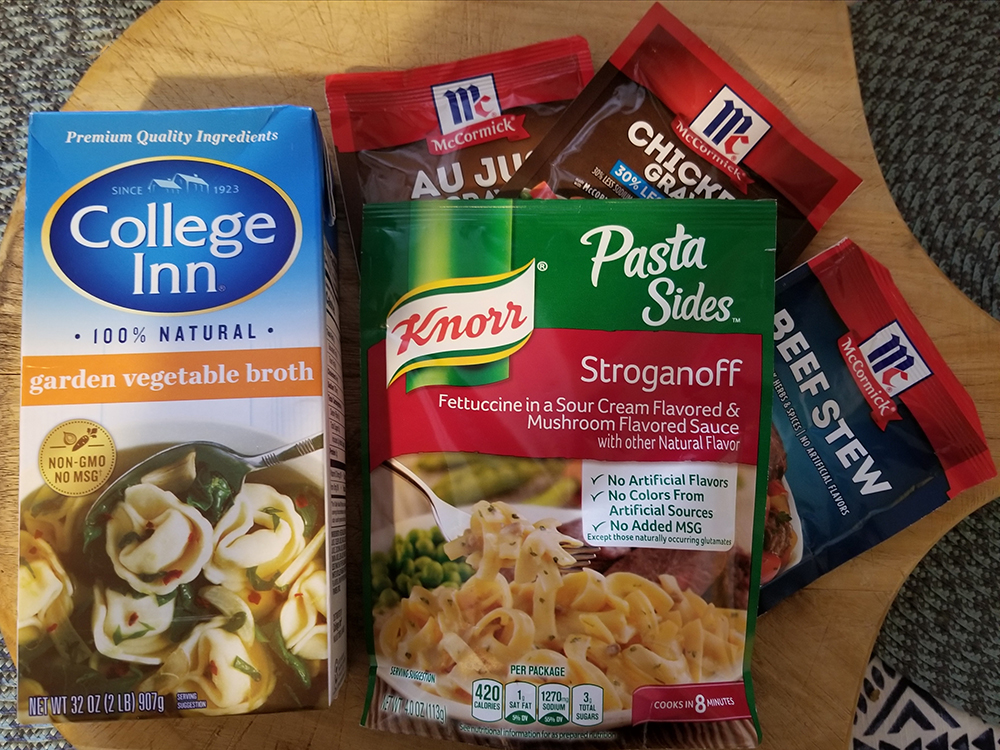
Being that the College Inn product sports a rather large “No MSG” symbol on the package front, we asked our Edelman contact if, according to their own high-profile campaign, that would constitute the same type of “racism” and “xenophobia” that we were accused of.
But despite several attempts to elicit an answer, Edelman has now gone dark on us. (We wondered if Del Monte would be looking for another PR firm should its executives connect the dots.)
Which only goes to show how even the best-intentioned causes, such as shining a spotlight on racism, can be distorted and manipulated by industry shills to cast other good causes, such as consumer protection, in a bad light.
Only in this case, the fact remains that keeping MSG out of your diet is no more “racist” than avoiding apple pie sweetened with HFCS is “un-American.”
If you have questions or comments, we’d love to hear from you. And if you have hints for others on how to avoid exposure to MfG, send them along, too, we’ll put them up on Facebook. You can also reach us at questionsaboutmsg@gmail.com and follow us on Twitter @truthlabeling






